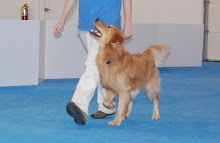Karin has got me reading one of her textbook: Motor Learning and Performance. And so, I’m learning more about learning and specifically about learning skills. On one end I’m thinking about how this relates to and applies to the skills we are teaching dogs, from a basic sit or down or stay in position, to the huge variety of agility skills. I’m also thinking about how this applies to the dog owners, learning how to do basic training all the way to agility handling. We often forget how much learning happens with the humans too!
One table lists proficiency levels from “early learning” to “later learning.” In early learning, the person is inefficient, has a lot of errors, is not so accurate, etc… With more practice the person is more proficient and efficient and has fewer errors. But at later learning, performances are automatic, fluid, and efficient. Most interestingly at this level is “Recognizes errors.”
I tend to be excited when I see this happening as I know people are thinking about what’s going on and know enough to know when things aren’t quite right. But I’ve tended to put this before “no error” not as a higher level of learning than being almost errorless.
A few situations where we see handlers recognize errors:
• Leash hand is drifting away from side, and then snaps back to “resting position.”
• Handler feeds for a stay so the dog has to streeeetch to reach the treat. Then the handler cringes and feeds a second treat with dog’s “chin tucked.”
• The treat hand moves before the click happens, then snaps back behind the handler’s back.
Dogs also learn to recognize errors too. This can be harder to see as the owners might be cueing the dog to move towards a correct performance. But dogs do recognize errors and move to a right response. (I want to say “correct” there but arg! That negative connotation in dog-ness!)
• Dog starts to move out of a stay but then relaxes back in position.
• Dog moves away during walking but snaps back to the handler’s side before getting to the end of the leash.
• Dog missed the weave pole entrance and started between 2 and 3… when he gets to the end and there’s a pole “missing”, he pauses or gives a confused look.
A benefit of being able to recognize errors not only indicates that we are able to recognize a right performance and what is –not- right. This can also enable more practice of correct responses at home and less practice of incorrect performances, which also furthers a good understanding of correct and accurate skills.
So… think about the errors you make in training without realizing it, the errors you do recognize, the errors your dog makes and recognizes, and how we can utilize this information to improve our training. And of course, it’s great if we don’t have errors… but sometimes they sneak in…!
Wednesday, July 14, 2010
Subscribe to:
Post Comments (Atom)




No comments:
Post a Comment